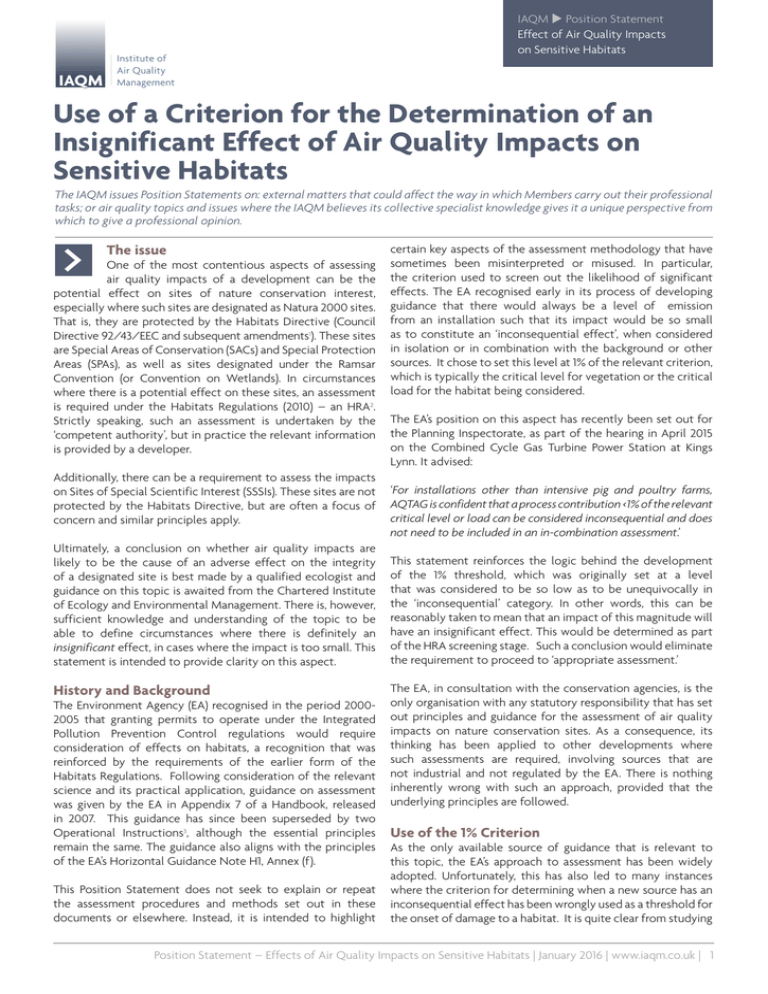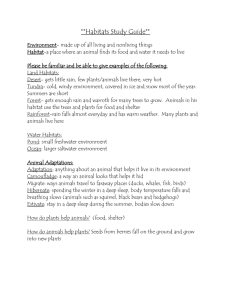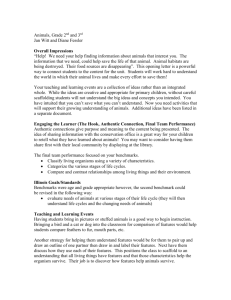the full position statement
advertisement

IAQM u Position Statement Effect of Air Quality Impacts on Sensitive Habitats Use of a Criterion for the Determination of an Insignificant Effect of Air Quality Impacts on Sensitive Habitats The IAQM issues Position Statements on: external matters that could affect the way in which Members carry out their professional tasks; or air quality topics and issues where the IAQM believes its collective specialist knowledge gives it a unique perspective from which to give a professional opinion. The issue One of the most contentious aspects of assessing air quality impacts of a development can be the potential effect on sites of nature conservation interest, especially where such sites are designated as Natura 2000 sites. That is, they are protected by the Habitats Directive (Council Directive 92/43/EEC and subsequent amendments1). These sites are Special Areas of Conservation (SACs) and Special Protection Areas (SPAs), as well as sites designated under the Ramsar Convention (or Convention on Wetlands). In circumstances where there is a potential effect on these sites, an assessment is required under the Habitats Regulations (2010) – an HRA2. Strictly speaking, such an assessment is undertaken by the ‘competent authority’, but in practice the relevant information is provided by a developer. Additionally, there can be a requirement to assess the impacts on Sites of Special Scientific Interest (SSSIs). These sites are not protected by the Habitats Directive, but are often a focus of concern and similar principles apply. Ultimately, a conclusion on whether air quality impacts are likely to be the cause of an adverse effect on the integrity of a designated site is best made by a qualified ecologist and guidance on this topic is awaited from the Chartered Institute of Ecology and Environmental Management. There is, however, sufficient knowledge and understanding of the topic to be able to define circumstances where there is definitely an insignificant effect, in cases where the impact is too small. This statement is intended to provide clarity on this aspect. History and Background The Environment Agency (EA) recognised in the period 20002005 that granting permits to operate under the Integrated Pollution Prevention Control regulations would require consideration of effects on habitats, a recognition that was reinforced by the requirements of the earlier form of the Habitats Regulations. Following consideration of the relevant science and its practical application, guidance on assessment was given by the EA in Appendix 7 of a Handbook, released in 2007. This guidance has since been superseded by two Operational Instructions3, although the essential principles remain the same. The guidance also aligns with the principles of the EA’s Horizontal Guidance Note H1, Annex (f). This Position Statement does not seek to explain or repeat the assessment procedures and methods set out in these documents or elsewhere. Instead, it is intended to highlight certain key aspects of the assessment methodology that have sometimes been misinterpreted or misused. In particular, the criterion used to screen out the likelihood of significant effects. The EA recognised early in its process of developing guidance that there would always be a level of emission from an installation such that its impact would be so small as to constitute an ‘inconsequential effect’, when considered in isolation or in combination with the background or other sources. It chose to set this level at 1% of the relevant criterion, which is typically the critical level for vegetation or the critical load for the habitat being considered. The EA’s position on this aspect has recently been set out for the Planning Inspectorate, as part of the hearing in April 2015 on the Combined Cycle Gas Turbine Power Station at Kings Lynn. It advised: ‘For installations other than intensive pig and poultry farms, AQTAG is confident that a process contribution <1% of the relevant critical level or load can be considered inconsequential and does not need to be included in an in-combination assessment.’ This statement reinforces the logic behind the development of the 1% threshold, which was originally set at a level that was considered to be so low as to be unequivocally in the ‘inconsequential’ category. In other words, this can be reasonably taken to mean that an impact of this magnitude will have an insignificant effect. This would be determined as part of the HRA screening stage. Such a conclusion would eliminate the requirement to proceed to ‘appropriate assessment.’ The EA, in consultation with the conservation agencies, is the only organisation with any statutory responsibility that has set out principles and guidance for the assessment of air quality impacts on nature conservation sites. As a consequence, its thinking has been applied to other developments where such assessments are required, involving sources that are not industrial and not regulated by the EA. There is nothing inherently wrong with such an approach, provided that the underlying principles are followed. Use of the 1% Criterion As the only available source of guidance that is relevant to this topic, the EA’s approach to assessment has been widely adopted. Unfortunately, this has also led to many instances where the criterion for determining when a new source has an inconsequential effect has been wrongly used as a threshold for the onset of damage to a habitat. It is quite clear from studying Position Statement – Effects of Air Quality Impacts on Sensitive Habitats | January 2016 | www.iaqm.co.uk | 1 IAQM u Position Statement Effect of Air Quality Impacts on Sensitive Habitats Use of a Criterion for the Determination of an Insignificant Effect of Air Quality Impacts on Sensitive Habitats the EA’s original guidance and its more recent statements that this is a false interpretation. Instead, in cases where an air quality impact is greater than 1% of a critical level or critical load, this should serve only as a trigger to consider the matter in greater detail with the involvement of a qualified ecologist, to consider the likelihood of an adverse effect on the integrity of the habitat. Furthermore, it should be recognised that the criterion was set as 1% and not 1.0%. It may be considered by some that it is prudent to explore the likelihood of an adverse effect when the impact is, say 1.2% of a critical load, but the reality is that this was never the original intention of the methodology. The calculation of impacts is always subject to some uncertainty, especially where deposition is concerned. It would be more in the spirit of the original proposal to use 1% as a criterion if impacts that were clearly above 1% were treated as being potentially significant, rather than impacts that are about 1% or slightly greater. About the Institute of Air Quality Management (IAQM) The IAQM aims to be the authoritative voice for air quality by maintaining, enhancing and promoting the highest standards of working practices in the field and for the professional development of those who undertake this work. Membership of the IAQM is mainly drawn from practising air quality professionals working within the fields of air quality science, air quality assessment and air quality management. Copyright statement Copyright of these materials is held by the IAQM. We encourage the use of the materials but request that acknowledgement of the source is explicitly stated. Regardless of these observations on the precision and accuracy of predicted impacts, it is the position of the IAQM that the use of a criterion of 1% of an assessment level in the context of habitats should be used only to screen out impacts that will have an insignificant effect. It should not be used as a threshold above which damage is implied and is therefore used to conclude that a significant effect is likely. It is instead an indication that there may be potential for a significant effect, but this requires evaluation by a qualified ecologist and with full consideration of the habitat’s circumstances. The criterion also is intended to apply to an individual source and is not intended to be applied to multiple sources ‘in combination’. References 1 More information available at: http://ec.europa.eu/ environment/nature/legislation/habitatsdirective/index_ en.htm. 2 Useful background material can be found at: http:// infrastructure.independent.gov.uk/wp-content/ uploads/2011/04/Advice-note-10-HRA-web.pdf. 3 Operational Instruction 66_12: Simple assessment of aerial emissions from new or expanding IPPC regulated industry for impacts on nature conservation; and Operational Instruction _67 Detailed Assessment of the impact of aerial emissions from new or expanding IPPC regulated industry for impacts on nature conservation. Position Statement – Effect of Air Quality Impacts on Sensitive Habitats | January 2016 | www.iaqm.co.uk | 2






